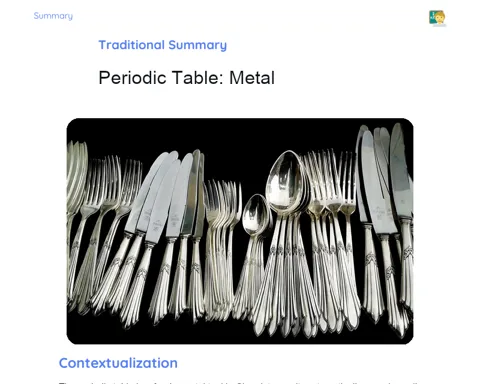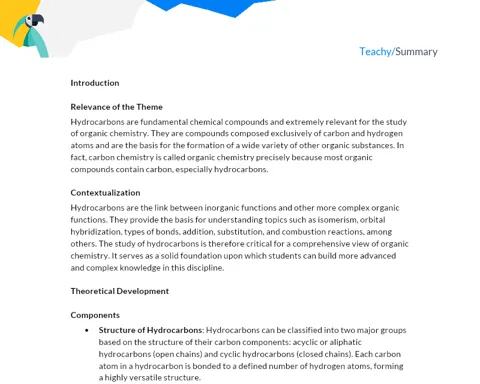Introduction
Relevance of the Theme
Phenol is a chemical compound of extreme importance. It belongs to the functional class of alcohols, with a hydroxyl group directly linked to an aromatic ring. Its structure and properties reinforce the essentiality of its study. Phenols, particularly phenol itself (C6H5OH), have a wide range of applications ranging from the plastics and resins industry to the healthcare sector as disinfectants and antiseptics.
Understanding the reactions of phenol is crucial for the comprehension of organic chemistry, as it explores a diversified and significant range of reactions and mechanisms. Furthermore, the study of phenol, along with other aromatic compounds, opens the doors to polymer chemistry and medicinal chemistry.
Contextualization
The study of phenols is situated within the broad field of organic chemistry. After learning about hydrocarbons, functional organic compounds, and their nomenclature, it is time to deepen the knowledge about specific functional classes. The study of phenols fits perfectly into this moment, building a valuable bridge between theory and practice.
By understanding the properties and behavior of phenols, you will be able to apply this knowledge to solve real-world problems, such as the synthesis and modification of substances in laboratories, industry, or even in medicine. Moreover, understanding the chemistry of phenol will help broaden your view on chemical interactions, deepening the understanding of what happens at a molecular level, one of the foundations of chemistry.
Therefore, the study of phenol is not only relevant due to its practical applications but is also an important element in forming an enhanced and more comprehensive understanding of organic chemistry.
Theoretical Development
Components
-
Structure of Phenol (C6H5OH): The structure of phenol is characterized by a benzene ring (aromatic ring of six carbons) with a hydroxyl group (-OH) directly linked to it. This direct linkage strongly influences the properties and reactivity of phenol, distinguishing it from aliphatic phenols.
-
Hydroxyl in Phenol and Acidity: The presence of the hydroxyl group gives an acidic characteristic to phenol. Unlike common alcohols, phenol can react with weak bases, forming phenoxide ions (C6H5O-) and water. This is possible due to the resonance of the π system, stabilizing the phenoxide ion.
-
Reactivity of the Aromatic Ring: The aromatic ring of phenol is highly reactive, susceptible to undergo a series of electrophilic reactions, such as nitration, sulfonation, halogenation, acylation, and alkylation. Each of these reactions contains details that are usually studied individually.
-
Influence of Substituents on the Aromatic Ring: Adding substituent groups to the aromatic ring of phenol directly affects its chemical and physical properties. For example, the presence of a methyl group (-CH3) in a phenol can make it less acidic compared to pure phenol.
-
Ortho and Para Effects in Substitutions on the Aromatic Ring: Substitutions in phenols can occur at the ortho, meta, and para positions relative to the -OH group. These substitutions are governed by the ortho and para effects (also known as the directing effect), which describe the preferential orientation of substituent additions on the aromatic ring.
Key Terms
-
Phenol: Functional class of aromatic alcohols, characterized by having a hydroxyl (OH) directly linked to a benzene ring.
-
Acidity of Phenol: Term describing the ability of phenol to donate a proton (H+) due to the stabilization of the phenoxide ion by resonance.
-
Resonance of Phenoxide: Process where electron delocalization through various alternative bonds is possible, making the phenoxide ion (C6H5O-) more stable.
-
Electrophilic Substitution on the Aromatic Ring (SEAr): Reaction where an atom or group of atoms is replaced by another atom or group of atoms and occurs on the aromatic ring.
Examples and Cases
-
Nitration of Phenol Reaction: Phenol reacts with nitric acid to form 2-nitrophenol and 4-nitrophenol as main products, an example of electrophilic substitution on the aromatic ring.
-
Formation of Phenoxide Ion: When phenol reacts with a base, the hydroxyl acts as a Bronsted-Lowry acid, donating a proton and forming the phenoxide ion (C6H5O-).
-
Comparison of Phenol and Methanol Acidity: Although both have a hydroxyl group and can react with a base, phenol is much more acidic than methanol due to the stabilization of the phenoxide ion by resonance.
-
Influence of Substituents on the Aromatic Ring: The presence of a methyl group (-CH3) in a phenol can modify the reactivity of phenol, making it less acidic.
-
Ortho and Para Effects in Phenol Alkylation: Phenol alkylation can result in a mixture of isomers, depending on the alkylation position. This fact can be explained by the ortho and para effects.
Detailed Summary
Key Points
-
Understanding the Structure of Phenol: Phenol is an aromatic alcohol, with a hydroxyl group directly linked to the benzene ring. This peculiar structure determines many of its chemical and physical properties.
-
Acidity of Phenol and Phenoxide Resonance: The presence of the hydroxyl group directly linked to the benzene ring gives phenol an acidic character. This acidity is due to the stabilization of the phenoxide ion by resonance, which differentiates phenol's acidity from common alcohols' acidity.
-
Reactivity of Phenol's Aromatic Ring: The aromatic ring of phenol is highly reactive and undergoes a variety of reactions, including nitration, sulfonation, halogenation, acylation, and alkylation. Each of these reactions has its own characteristics and considerations.
-
Influence of Substituents on the Aromatic Ring: Adding substituent groups to the aromatic ring of phenol has a direct impact on its chemical properties. For example, the presence of a methyl group (-CH3) can alter the acidity of phenol.
-
Ortho and Para Effects: This effect describes the preferential orientation of substitution reactions on the aromatic ring of phenol. Understanding this concept is essential to predict the products of reactions with substituted phenols.
Conclusions
-
Versatility of Phenol: Phenol is a compound with very diverse practical applications, from industry to medicine. Its study deepens the understanding of organic chemistry and allows the application of this knowledge in various situations.
-
Importance of Structural Analysis: Understanding molecular structures is essential to predict the properties and behaviors of a compound. The structure of phenol, with its hydroxyl group directly linked to the aromatic ring, is decisive for its characteristics.
-
Reactivity of Functional Groups: The study of phenol chemistry contributes to the general understanding of the reactivity of functional groups, in this case, the hydroxyl group in an aromatic compound.
-
Keeping an Eye on the Responses: Adding substituent groups to the aromatic ring of a phenol can significantly alter its properties. It is necessary to consider these modifications when studying or manipulating compounds that contain phenols.
Suggested Exercises
- Identify the chemical function of the following compound and name it according to IUPAC: C6H5OH
- Compare the acidity of phenol (C6H5OH) and methanol (CH3OH) and explain the reason for the differences in acidity.
- Write the balanced chemical equation for the nitration and sulfonation reactions of phenol. Indicate the main products of each reaction.



